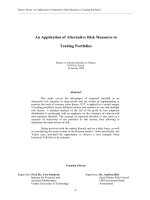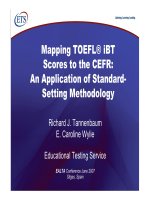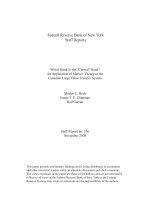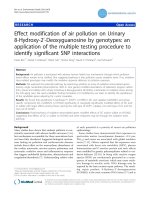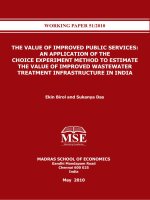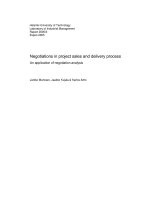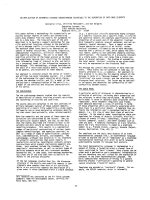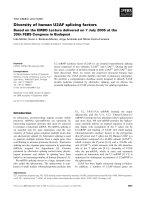AN APPLICATION OF FAMA FRENCH 3 FACTORS MODEL ON HOSE
Bạn đang xem bản rút gọn của tài liệu. Xem và tải ngay bản đầy đủ của tài liệu tại đây (537.32 KB, 44 trang )
JEAN MOULIN LYON 3 UNIVERSITY
VIETNAM UNIVERSITY OF COMMERCE
MASTERS FINANCE AND CONTROL
THESIS
AN APPLICATION OF FAMA FRENCH 3 FACTORS MODEL ON HOSE
Supervised by: OUSSAMA LABILI
Hà Nội - 2013
1
ACKNOWLEDGEMENTS
I am sincerely thankful to my supervisor Oussama Labili from the Jean Moulin Lyon 3
University, for his encouragement, guidance and feedback from the beginning to the final
stage.
I would like to show my great gratitude to Mr Vu Manh Chien, Mr Vu Duc Khuong, Mr
Nguyen Viet Dung for their detailed comments and valuable suggestions.
In addition, I would like to show my gratitude to my classmates, Tuyet Dinh Thi Anh among
others, for their useful discussions and assistance.
I would like to express my sincere thanks to all of my lecturers for their teaching and
guidance during my master course at the Jean Moulin Lyon 3 University and Viet Nam
Commercial University.
Finally, I am also grateful to my family for their emotional, moral as well as financial support.
Responsibility for any remaining errors lies with the author alone.
2
Contents
1. INTRODUCTION................................................................................................................5
1.1. Overview of Research...............................................................................................................................5
1.2. Research Objectives..................................................................................................................................6
1.3. Research Structure....................................................................................................................................6
1.4. Previous Research in Viet Nam................................................................................................................6
2. LITERATURE REVIEW....................................................................................................8
2.1. The Fama French 3 factors model............................................................................................................8
2.2. Extended Fama-French 3 factors model- Carhart (1997) four factor model.........................................10
2.3. Empirical evidence of Fama French......................................................................................................11
2.3.1 Empirical of Fama French model in developed markets.....................................................................11
2.3.2.Empirical evidence of Fama French model in emerging markets........................................................14
3. DATA..................................................................................................................................14
4. METHODOLOGY.............................................................................................................16
5. EMPIRICAL RESULT.....................................................................................................19
5.1. Test Result Summary..............................................................................................................................19
5.1. Testing for Errors..................................................................................................................................21
6. CONCLUSION...................................................................................................................23
6.1. Research Summary.................................................................................................................................23
6.2 Contributions, limitations and recommendations....................................................................................23
6.2.1 Contributions........................................................................................................................................23
6.2.2 Limitations............................................................................................................................................24
6.2.3 Recommendations.................................................................................................................................24
REFERENCES.......................................................................................................................26
APPLENDIX 1: 120 TICKER LISTED IN HOSE FROM JUL 2008 TO JUN 2013......30
APPLENDIX 2: RISK-FREE RATE (VIETNAM 2 YEAR BENCHMARK BOND – BID
YIELD) AND VNINDEX......................................................................................................36
APPLENDIX 3: PORTFOLIO RETURN (ALL 120 TICKER, SH, SM, SL, BH, BM,
BL)...........................................................................................................................................37
APPLENDIX 4: TEST RESULT.............................................................................................40
3
Abbreviations
HOSE
: Ho Chi Minh City Stock Exchange
HASTC : Ha Noi Stock Trading Center
CAPM
: Capital Asset Pricing Model
P/E
: Price to Earning
BE/ME
: Book equity/Market Equity
HML
: High minus Low
SMB
: Small minus Big
WML
: Winner minus Loser
IPO
: Initial public offering
SEO
: Seasoned equity offering
HNX
: Ha Noi Stock Exchange
4
1. INTRODUCTION
1.1. Overview of Research
The Viet Nam stock market has been formed since July, 1998. Having some certain
achievements, there is still riskiness and weakness. Currently, in Viet Nam, most of
investment decisions of individual investor and business were based on recommendations of
securities companies which using discounted cash flow method or relative method. However,
with the current volatility of the market, these methods proved to be inefficient and could not
predict the real market price of stock. So that investors could not make decisions in a more
flexible way. Therefore, the study of the application of modern financial theory of investment
in Viet Nam stock market in the current period is very important and urgent. Moreover, there
were several researches in the world in applying of the theory of financial investment in the
stock market, especially the empirical research on the stock market in emerging countries.
These researches gave significant and extremely practical results. It reinforces more accuracy
and empirical models. Seeing the need of the application of the asset pricing model to predict
the stock market, I decided to investigate research topic: AN APLICATION OF FAMA
FRENCH 3 FACTORS MODEL ON HOSE (HO CHI MINH CITY STOCK EXCHANGE).
The Fama French 3 factors model has been one of the most widely used techniques in the
global investing community for calculating the required return of risky asset but it seems very
new in Viet Nam. This is the reason that motivates me empirically analyse the Fama French
model in the context of Viet Nam stock market.
This project aims to test whether Fama French model is a valid model for estimating risk and
return of stocks listed on the HOSE.
The study’s result might be useful recommendations for investor about how and what Fama
French can be used for predicting risk and return and making investment decision in Viet
Nam stock market.
5
1.2. Research Objectives
With the motivation of specifying appropriate measurement for investors to evaluate risk and
return, this study’s main objective is to evaluate the explanatory power of this model in Viet
Nam stock market. While most empirical tests of this models’ validity conducted with HOSE
data. Therefore, this study will re-examine the forecasting capability of Fama French 3 factors
model for 120 companies listed on HOSE which is listed from July 2008 to June 2013. The
study will examine the effect of market premium, size premium and book value/market value
premium to the stock and portfolio. It is expected to estimating risk and return of stock and
portfolio during the period of down-turn to find whether this model is suitable to evaluate cost
of equity in Viet Nam stock market or not?
1.3. Research Structure
I intend to organize my study as follows: section 1 introduces the thesis topic, section 2
reviews the literature on Fama French model. Section 3 describes the data of 120 companies
in HOSE (excluding banks, insurance companies, securities firms), which is employed to test
the predicting capability of explanatory variables. Section 4 discusses about the methodology
which is used to conduct the testing. Section 5 reports and analyses the empirical test results.
In final section, summary and limitations of the study are provided.
1.4. Previous Research in Viet Nam
In Vietnam, there are few previous studies on capital asset pricing model, as Vietnam stock
market has been formed 15 years ago. So I will summarize some typical researches on CAPM
and Fama French in Viet Nam.
In 2009, Doctor Quach Manh Hao, a lecturer at the National Economics University, has a
research “Finding an asset pricing model in Viet Nam” posted in Financial Market imagine.
He collected 50 stocks on HOSE and HASTC from 2007 to 2009. He found that there were 4
most important factors that effect to stock return: Rm, P/E, liquidity and company size. He
applied Fama French model and found the result: R2: 55% and confidence level: 95%.
In 2010, Vuong Minh Giang has a research ''An Empirical Examination of the Validity of the
CAPM in the Vietnamese Stock Market” at Social Science Research Network. The author
collected data from 30 largest capitalization stocks in the period 2007-2009. The linear
6
relation between risk and rate of return in Vietnam stock market is tested for the falling period
2007-2009 based on adjusted-price data. As a result, the failure of the test shows that VNIndex, conventionally regarded as the "market portfolio", is not mean-variance efficient to the
asset set being examined. By optimization calculation, a general envelope containing the
efficient frontier of the stock set in the Vietnamese case of short-sales restrictions is produced.
Finally, some remarks are noted for stock pricing practice in the emerging market.
In 2011, a group of students in Ho Chi Minh Economics University conduct a research,
namely “Application CAPM and Fama French Model in Viet Nam stock market”. The authors
collected data from 88 stocks from 2007 to 2010 and reach a result as follow: R 2 is 90.56%
and confidence level is 95%
In my study, I would like to confirm that I cannot create a new model but basing on the result
of previous researches in Viet Nam and Fama French methodology, I want to conduct a
intensive study with more observation in a longer period, through a bigger portfolio (120
tickers) to find out more useful results.
7
2. LITERATURE REVIEW
2.1. The Fama French 3 factors model
The capital asset pricing model is a set of predictions concerning equilibrium expected returns
on risky assets. Harry Markowitz laid down the foundation of model portfolio management in
1952. The CAPM was developed 12 years later in articles by William Sharp, John Lintner and
Jan Mossi. The time for this gestation indicates that the leap from Markowitz’s portfolio
selection model to the CAPM is not trivial.
CAPM tests the relation between market risk and asset return, assuming that investors are
risk averse and only mean and variance of their assets return are occupied. Thus, the portfolio
is chosen if it can minimize loss, given expected return or maximize return at a certain level
of risk.
The CAPM equation is as follows:
Denote E(ri) and E(rM) as expected return of asset i and market portfolio, respectively.
Rf is the return of risk-free asset.
is the relationship between excess expected return of asset i and that of market
portfolio as a fraction of total variance of market portfolio .
In Roll’s critique, he also points out a number of drawbacks of CAPM such as its implication
of market efficiency or formation of market portfolio which challenge the practical of the
model. Roll and Ross (1994) and Kandel and Stambaugh (1995) support for Roll’s view.
They argue that CAPM provides an adequate evaluation of beta only in an efficient market
which is hardly measured in the real world. Thus, it is uncertain about the predicting
capability of CAPM. Besides, numerous studies suggest other factors which might outweigh
beta in estimating companies’ return such as price to earnings (Basu, 1977), firm size (Banz,
1981 and Reinganum, 1981). Findings of other significant variables in explaining rate of
return imply the need to incorporate additional factors to modify CAPM (Lawrence et al,
2007).
8
Fama and French (1992) confirm the insufficiency of CAPM by illustrating a weak relation
between market beta and average US return of the period 1963-1990 by cross-sectional test.
They point out other variables, namely E/P, leverage, firm size (market equity) and book to
market equity (hereafter BE/ME) can explain the stock returns. Combining these variables,
two latter variables seem to absorb explanation power of the two former. In short, firm size
(market equity) and BE/ME could enhance CAPM’s efficiency in pricing stocks.
Fama French three factors model is presented as follow:
Where
term;
,
,
,
,
,
are expected premiums,
is a constant
are parameters in the regression.
The ex-post regression of Fama French three factors model is given by:
Where
,
are excess asset and market return, respectively.
Fama and French’s later study (1993) expands the previous one in three dimensions. First,
they involve US government and corporate bonds in the set of tested assets instead of stock
only in Fama and French (1992). Second, one more variable, term-structure, which plays an
important role in bonds’ value, is added. In their theory, bonds and stocks might be closely
related as markets are integrated. Hence, they try to test whether a crucial variable of bonds
has significant explanation power to stocks’ returns or not, and vice versa. Third, the
methodology used to examine assets’ returns is different. If bonds is included in the crosssectional regression, size and BE/ME variables have no relation to bonds. Therefore, Black,
Jensen and Scholes (1972)’s approach, a time series regression, is adopted while crosssectional test in Fama French (1992) might be unsuitable in this case. Portfolios are therefore
formed on size and book to market equity. It is suggested that size factor be equal to the
monthly average return of small companies minus that of big companies, denoted by SMB
(small minus big). The other explanatory variable, book to market is the difference between
9
return of stocks with high book to market ratio and that of stock with low book to market
ratio, given by HML (high minus low).
Fama and French (1995, 1996a) continue to prove the outperformance of Fama-French three
factors model compared to CAPM, using time series regression. They point out the trend that
strong firms with high earnings usually have low book to market equity and negative slope on
HML. In contrast, weak firms with low earnings tend to have high book to market equity and
positive slope on HML.
2.2. Extended Fama-French 3 factors model- Carhart (1997) four factor model
Mark Carhart (1997) continues the momentum issue studied by Jegadesh and Titman (1993).
He constructs a risk factors relating to momentum effect (WML- Winner Minus Loser) and
makes a four factors model by adding momentum factor into the Fama French 3 factors
model. The momentum effect is the effect that past winner or loser continues performing well
or poorly. The WML factor is measured by the return of winner stocks portfolio minus the
return of loser stocks portfolio. As momentum strategy, the investors buy the stock with
higher returns as well as sell stocks with lower return over the previous 3 to 12 months could
largely generate returns in the stock market.
The theoretical model of 4 factors regression is as follow:
Where: WML is the return difference between past 1 year winner and loser portfolios,
is
parameters in the regression and the others are the same in Fama French model.
From the result of Carhart’s study, we get the flowing suggestion. We should not invest in the
funds that their rate of returns always are negative. The funds that having the high return in
the year before will continuously generate the higher return in the year after, but it is not
accurate in a long term. Management cost, total net asset, investment cost effect directly and
inversely to fund’s return and take away the excess return of the fund having high return in
the year before in a long term.
Toward the result of Carhart (1997), Daniel et al.(1997) and Wermers (1997) find evidence
that four factor model of Carhart (1997) does well in investigating the strategies that drive the
persistence in mutual fund performance. Brave et al.(2000) reveals that the four factors model
10
of Carhart could explain the underperformance in return from a sample of IPO (initial public
offering) and SEO (seasoned equity offering) companies.
In fact, results from some research in the global indicated that the four factors model have
significant exposure in explaining the variations in average excess stock return. R2 from
Carhart model is just slightly higher than Fama French model.
In Viet Nam, a group of students in Ho Chi Minh Economics University (2011) conduct a
research, namely “Application financial models in pricing investment portfolio in Viet Nam
stock market”. They find that four factor model of Carhart have higher capability in
explaining the variations in average excess portfolio return. R 2 in CAPM, Fama French and
Carhart is respectively 71.66%, 86.23%, 88.41%.
2.3. Empirical evidence of Fama French
2.3.1 Empirical of Fama French model in developed markets
Evidence of Fama French three factors model can be seen mostly in US market such as Fama
and French (1992, 1993, 1995, 1996a, 2006). In these studies, Fama and French show
statistically insignificant of the CAPM factor in estimating cost of equity during different
periods of time in the US market. Meanwhile, size and book to market factor are proved to
have a significant role in explaining asset return (ibid). In contrast, examining the validity of
the two models in the US, Bartholy and Pearre (2005) find out that there is no significant
difference between their estimates. Thus, they raise the issue that whether or not the other two
variables of Fama French should be adopted while they insignificantly contributed to cost of
equity evaluation.
According to Drew and Veeraraghavan (2003) and Artmann et al (2012), the efficiency of an
asset pricing model is strongly proved if its evidence is shown in sufficient new markets
rather than only in the biggest one. Using Australia data for the period 1981-1991, Halliwell
et al (1999) show the significance of Fama French factors in explaining Australian average
returns. But the role of BE/ME is not as powerful as it has been proved in Fama French’s
studies. Faff (2004) continues to research the validity of the Fama French model in Australia
market, dealing with daily data of industry portfolio from 1 May 1996 to 30 April 1999. His
finding basically supports Fama French factors. In the case that an estimated risk premium is
considered, robustness of the model is decreased. Expanding the examined time from 1982 to
2006, Brailsford et al (2012) prove the superior performance of Fama French model in
11
comparison with CAPM in evaluating Australia stocks. Their empirical test results show the
statistical significance of book to market factor and the opposite in case of size effect in
explaining assets’ returns.
However, studying Germany firms’ data for the period from 1969-2002, Schrimpf et al (2007)
support the traditional asset pricing model, CAPM, rather than the modern one, Fama French
in the sense that it provides less error than its counterpart. Also dealing with German market
but for longer stage, 1960-2006, Artmann et al (2012) reject the explanatory power of both
CAPM and Fama French model. There is limited statistical evidence on both size and book to
market effect in German stock returns (ibid).
Chan and Chui (1996), when testing Fama French model for UK companies during the period
1971-1990, found out the significance of book to market factor but insignificance of firm size
factor in explaining stock returns. Meanwhile, Zhang (2009) and Chabi-Yo and Fourseni
(2009) demonstrate the strong capability in estimating UK stock returns of Fama-French
factors. Testing UK companies between 1975 and 2000, Hung et al (2003) combine Fama
French factors with the CAPM, then examine whether the additional factors support
explanatory power of CAPM beta or not. They conclude that both CAMP beta and Fama
French factors are significant in estimating the cross-section of UK stock returns. Similarly,
using UK data (1992-2001), Charitou and Constantinidi (2003) sum up with the
outperformance of Fama French model over the CAPM.
Various applications of the model result in conflicting conclusions about the explanation of
Fama French model. Kothari et al (1995) argue that book to market has a marginal relation to
expected stock returns. In their points of view, Fama and French (1992, 1993)’s results are
due to survivor bias in COMPUSTAT data. This data source usually includes historical firms’
data in which survivor companies used to have unexpected higher return than the dead ones.
Thus, there might be a positive bias for the former (high book to market equity) in
comparison to the latter. On the contradictory, Chan et al (1995) and Fama and French
(1996b) illustrate that survivor bias plays no role in explaining the relation between average
return and book to market equity. In their arguments, omissions in COMPUSTAT data are
financial institutions which have higher leverage than other types of firms. The missing firms
do not cause survivor bias. Additionally, Fama and French (1993) use value-weighted
portfolios in their test. Survivor bias does not matter in these portfolios as high weights are
given to large companies.
12
Black (1993) and MacKinlay (1995) state that the value premium of Fama-French’s factors
stems from data-snooping, whereas Lakonishok et al (1994) suggest, it is due to behavior of
investors. As investors are used to buying stocks which are big and well-performed in the
past, thus, overprice these stocks. Conversely, they tend to sell stocks which might be small
but have high growth rate. Thus, these stocks are underpriced. La Porta (1996) shares the
same idea that investors might favor value stocks as they concentrate on these firms’ enduring
development rather than those with rapid growth rate. Fama and French (1992) suppose that
investing in growth stocks which are small and have high book to market ratios should reward
higher returns as bearing higher risks.
Extending Fama and French (1992)’s research, Knez and Ready (1997) also apply Fama and
Macbeth procedure in their study. They compare a standard least square regression with a
least trimmed square regression which monthly omits 1% most extreme observations. The
results suggest that these trimmed observations are reasons for negative relation between firm
size and its average return. Without them, coefficient of size in the regression for stocks’
return is significantly positive. They share the same idea with Fama French (1992)’s
explanation that investors who bearing risk investing in small firms should reward high
returns. It is suggested that there should be systematic driven forces for risk premium which
also help explaining firm’s development process. Vassalow (2003) points out a significant
factor in explaining stock return that is news related to future GDP growth. His study
illustrate that including the variable in CAPM model dramatically increases its explanatory
power. Moreover, the existence of news related to future GDP growth might outweigh HML
and SMB role in pricing equities. Thus, there might be a close relation between HML, SMB
variables and news about future GDP development.
Initially stated by Banz (1981), size effect has been found in all common stocks listed on
NYSE from 1926 to 1975. In his study, small firms are proved to bear higher risk than large
ones. These former stocks provide significantly higher average returns than the latter ones.
According to Banz (1981), one possible explanation for the phenomenon is limited
information of small firms which leads to higher risk-adjusted returns for holding these
stocks. Studying the same topic, Chan and Chen (1991) examine risk and return characteristic
of 19 industry groups on NYSE during the period 1956-1985. In their findings, production
efficiency, leverage and the ability to absorb external capital cause higher risk of small firms
than large ones. Zarowin (1990) also concludes a size effect in stocks’ returns when re-
13
examining the overreaction hypothesis stated by DeBondt and Thaler (1985). The hypothesis
is about the outperformance of loser to winner stocks. Following Zarowin (1990), losers tend
to be small stocks and vice versa. When winners are smaller than losers, they provide higher
returns than the latter.
2.3.2.Empirical evidence of Fama French model in emerging markets
There is limited evidence on Fama French model’s validity in Asian countries. As Drew and
Veeraraghavan (2003) has observed, Chui and Wei (1998) are first examining the validity of
Fama French in Asian market. Their finding proves the significance of two more factors in
Fama French, firm size and book to market. In their study, the relation between market beta
and average return is weak, as opposed to that of Fama French factors. Similarly, Drew and
Veeraraghavan (2002, 2003) once comparing the validity of two models in emerging markets
(Malaysia, Hongkong, Korea and Philippines) during the 1990s, point out the outperformance
of Fama French over CAPM model. More recently, Taneja (2010) also confirms strong
explanatory power of Fama French in comparison with CAPM in Indian stock market, from
June 2004 to June 2009. His result shows that variations in stock average return can be
captured better by multifactor Fama French model than single factor model CAPM. Using
Shanghai Stock Exchange data, Lin et al (2012) illustrates the superior explanation power of
Fama French factors in estimating portfolios’ returns in China market. However, it is shown
in their study that market factor seems to be more appropriate in evaluating individual stock’s
return.
3. DATA
Kothari, Shanken and Sloan (1995) report that beta from annual returns produce stronger
positive relation between beta and average return than beta from monthly return. But FamaFrench (1996) prove the contrast conclusion that annual and monthly returns have same
inferences about beta premium.
This study uses historical monthly data of 120 Viet Nam companies based on the following
criteria:
Listed in HOSE at least 60 months (before July 31 2008). De-listed companies and
those which are listed after July 2008 are excluded to maintain the continuation of
portfolios.
14
Banks, insurance companies, securities firms are excluded because of their distinctive
high leverage.
Fiscal year ended on 31 December.
All stock price used in this document are adjusted close price (A stock's closing price on any
given day of trading that has been amended to include any distributions and corporate actions
that occurred at any time prior to the next day's open).
VNIndex, July 2008 to June 2013. Data Source: cafef.vn
These figures, adjusted prices, shares outstanding, owner equity as well as other companies’
financial information are obtained from and Thomson Reuters Eikon.
After collecting all data basing above criteria, I regress data on monthly return of 120 testing
stocks in 60 months, from July 2008 to June 2013.
15
Vietnam 2-Year Benchmark Bond, July 2008 to June 2013. Data Source: Thomson Reuters
Risk-free rate of return is Vietnam benchmark bond. Data on the risk-free interest is
statistically Bid Yield of 2-Year Viet Nam benchmark bond, because these bonds are traded
widely and have the highest liquidity in the market.
The sample is divided in a way that the proportions of small and big size, high and low B/E are
equal. Our definition of Small size (S), Big size (B), High BE/ME (H), Medium BE/ME (M), Low BE/ME
(L) as following:
Type of
company
H
M
L
All
Type of
company
B
S
All
Max of BE/ME
Number of
companies
Min of BE/ME
11.8
2.4
1.4
11.8
2.5
1.4
0.3
0.3
Max of Market capital
Min of Market capital Number of
(VND)
(VND)
companies
11,448,216,000,000
140,000,000,000
137,838,943,100
19,066,956,300
11,448,216,000,000
19,066,956,300
4. METHODOLOGY
The time regression of three-factor Fama-French model is presented by the equation below:
16
36
48
36
120
60
60
120
(1
)
The dependent variable of the regression is the excess return of company (i) in month (t). But
besides market factor, size (SMB – Small minus Big) and book-to-market (HML – High
minus Low) factors are two additional explanatory variables. The exposures of firm (i) excess
return to those risk factors are denoted by βiM, βiSMB and βiHML correspondingly.
Additional Fama-French factors are formed basing on six value-weight portfolios constructed
by size and book to market ratio. With regards to size, companies included in the sample will
be divided into two groups following its market capitalization rank, i.e. big and small. The
median is used as a size breakpoint. The book to market ratio or year t is computed by
dividing book value at the beginning of testing period t with market value at the same time of
year t.
By ordering individual company’s book-to-market ratio, tested companies are categorized into
three groups: low, medium and high. 30% bottom of the order contributes to the low group
whereas 30% top belongs to high group. The intersections of two-size and three book-tomarket ratio groups create six portfolios, namely Small High, Small Medium, Small Low, Big
High, Big Medium and Big Low. For example SL is a portfolio of companies with small size
and low book value/market equity.
Small size
Big size
High BE/ME
SH
BH
Medium BE/ME
SM
BM
Low BE/ME
SL
BL
Determine and calculate SBM and HML Variable
SMB (Small minus Big) represents the risks related to the effect of the size factor. SMB is the
average monthly return of three small portfolios minus average return of three big portfolios,
given by:
SMB =1/3(Small High + Small Medium + Small Low) – 1/3(Big High + Big Medium + Big
Low)
17
HML (High minus Low) represents the risks related to the effects the book value/market
value factor on stock return. HML is the average monthly return of two high book-to-market
ratio portfolios minus average return of two low books to market ones.
HML = 1/2 (Small High + Big High) – 1/2 (Small Low + Big Low)
Rate of Return of portfolio:
Average monthly rate of return of the portfolio: based on the daily closing price of the stock,
I compute the return for each stock. Because Viet Nam stock market has been formed since
July 1998 so that the data to compute yearly return is not enough. Daily return computing is
not chosen due to fluctuation amplitude effect. This study uses historical monthly data of 120
Viet Nam companies listed on HOSE over a 60-month-period, from July 2008 to June 2013.
The return of each stock is computed by the flowing formula:
Where
is the return of stock i at period t+1,
period t, and
is the market price of stock i at the end of
is the market price of stock i as the end of period t+1.
Since then, the portfolio return is calculated by the average monthly return of all stock in the
portfolio.
Market Return and Free Rate Return:
Rf is rate of return earning by investing 2 years Viet Nam government bonds. R m is market
return that testing stock listed. Therefore, in this research, I choose VNIndex to calculate R m
for the stocks listed on HOSE.
Market return is computed by the flowing formula:
Rm
VNindext+1- VNindext
=
VNindext
18
Where
period t,
is market return (VNIndex return), VNindext is the value of VNIndex as the end of
is the value of VNIndex as the end of period t+1.
19
5. EMPIRICAL RESULT
5.1. Test Result Summary
We will test the time regression of three-factor Fama-French model presented in equation (1)
by running the Ordinary Least Squares tests using Gretl with 7 portfolio: allTicker-Rf (the
portfolio of all 120 tickers), BH, BM, BL, SH, SM and SL. The detail test results are
presented in Appendix 4: Test Result.
We have the following summary table:
Dependent
Variable
Independent
Variables
beta_SMB
beta_HML
R2
Average
R2
0.941559
0.311124
0.41876
0.894366
0.894366
0.798779
-0.0877892
1.04639
0.870012
0.809445
0.782955
0.782208
0.81094
0.798032
0.0879176
-0.189014
0.905105
0.899679
1.00633
0.418132
0.284276
1.12466
0.737358
-0.11322
0.843375
0.837355
0.905262
0.79442
0.709532
alpha
beta_M
allTicker-Rf
-0.00570694
BH
0.0854197
0.0883569
0.0802218
0.0828034
0.0831937
0.0880013
BM
BL
SH
SM
SL
HML, SMB,
Rm_minus_Rf
0.826659333
First, we run regressions on the portfolio of 120 securities (allTicker-Rf) and we found that
= 89.43%, and the confident level of HML and Rm_minus_Rf is 99%. However, the
confident level of SMB is only 90%. The SMB having lower statistical significance indicates
that it is less significant difference between small and big size performance, while the high
BE/ME performance are significantly different from those of Low BE/ME. As a result, the
HML has higher predictive power than the SMB in forecasting excess return.
Continue to conduct regression by small portfolios, which are divided based on the scale
factor and the ratio of BE/ME. Preliminary assessment, in large group (BH, BM, BL), SMB
regression coefficients showed no statistical significance, the remaining coefficients are very
good reliability.
In small group (SH, SM, SL), only in the SL portfolio, HML regression coefficient is not
statistically significant.
In 6 portfolio, SH has the highest R2 (90.52%), SL has the lowest R2 (70.95%).
20
